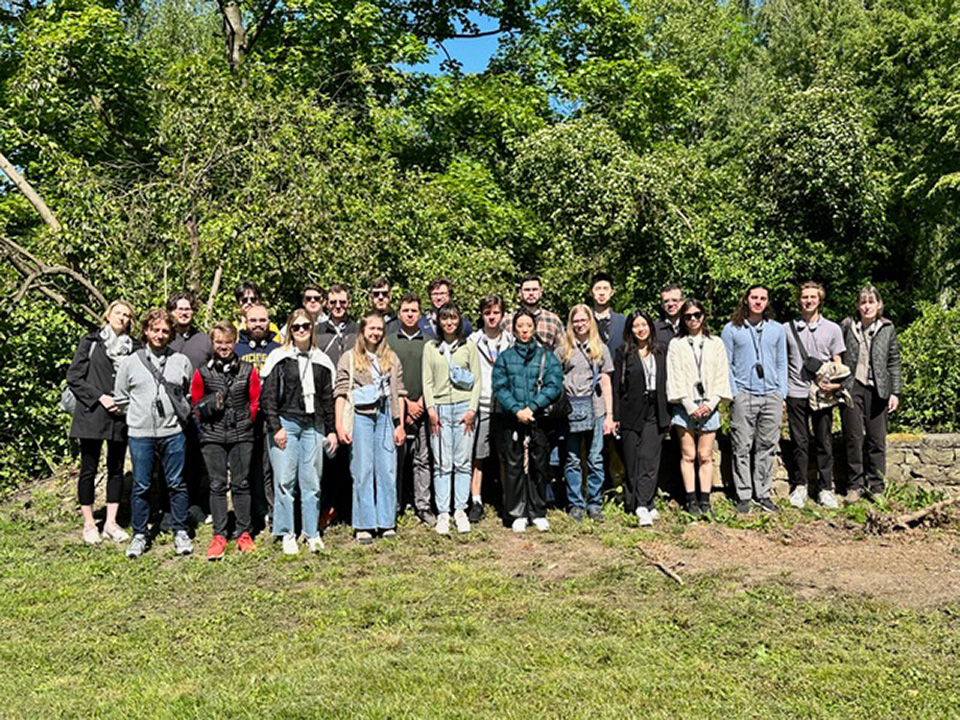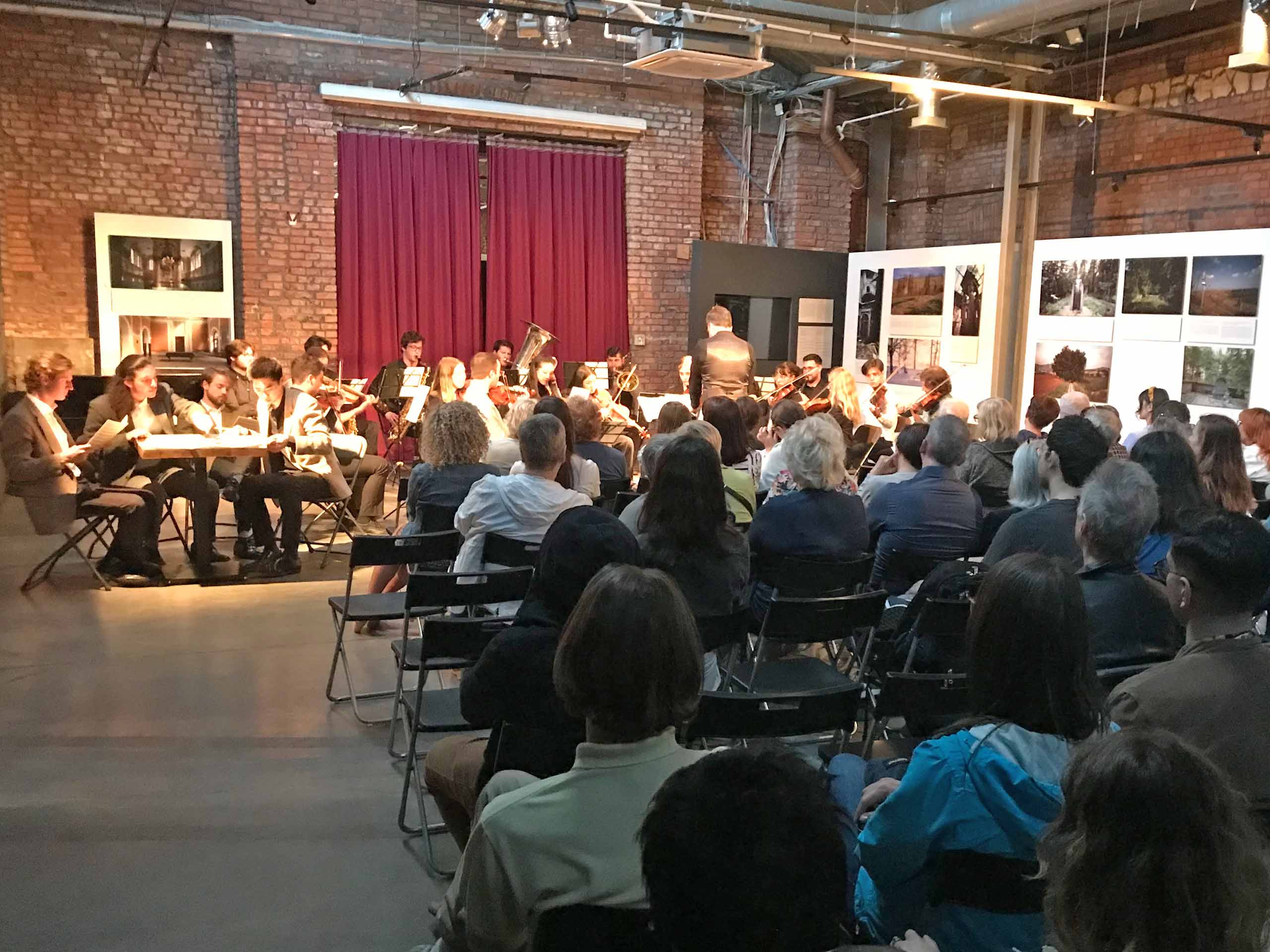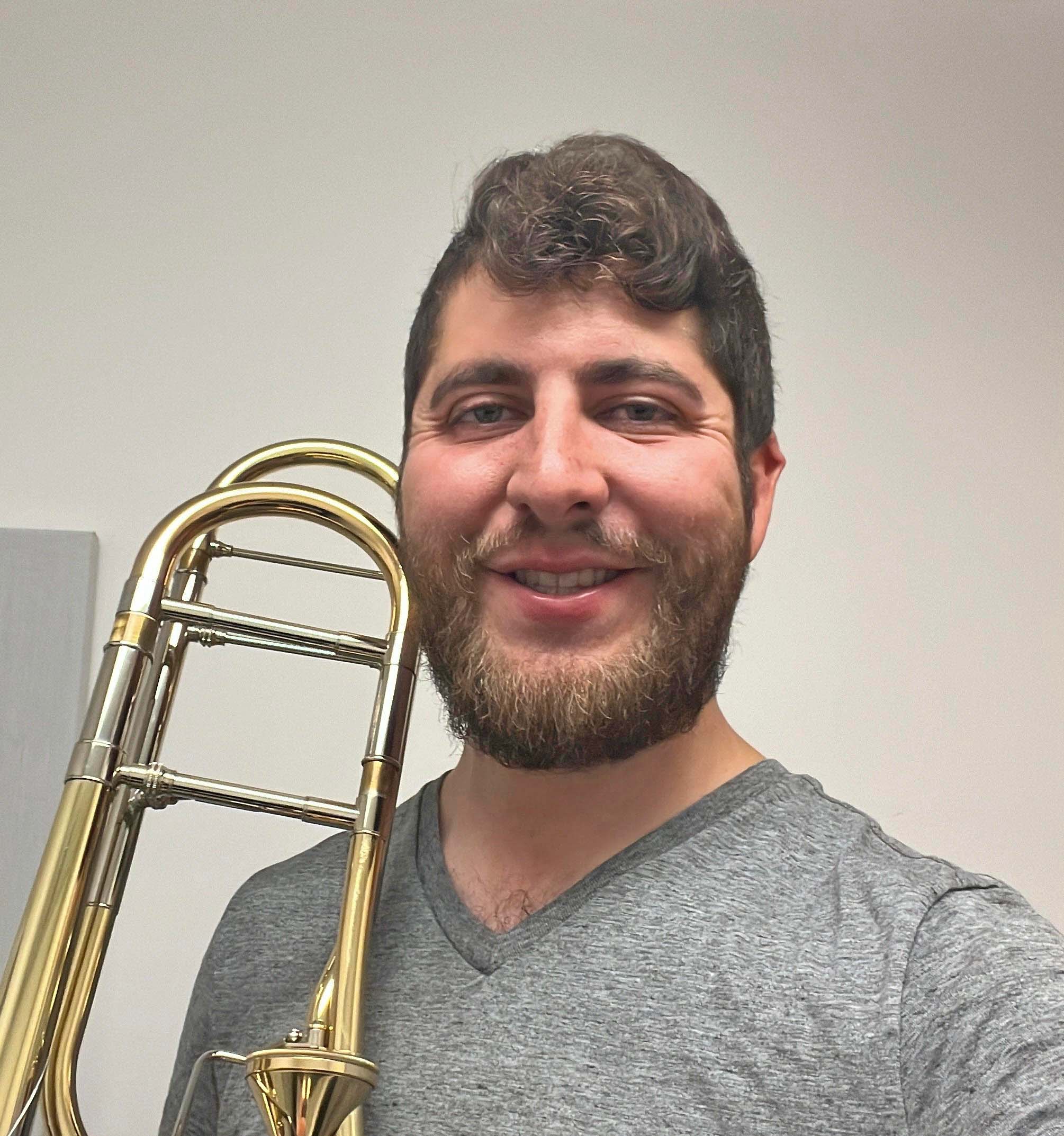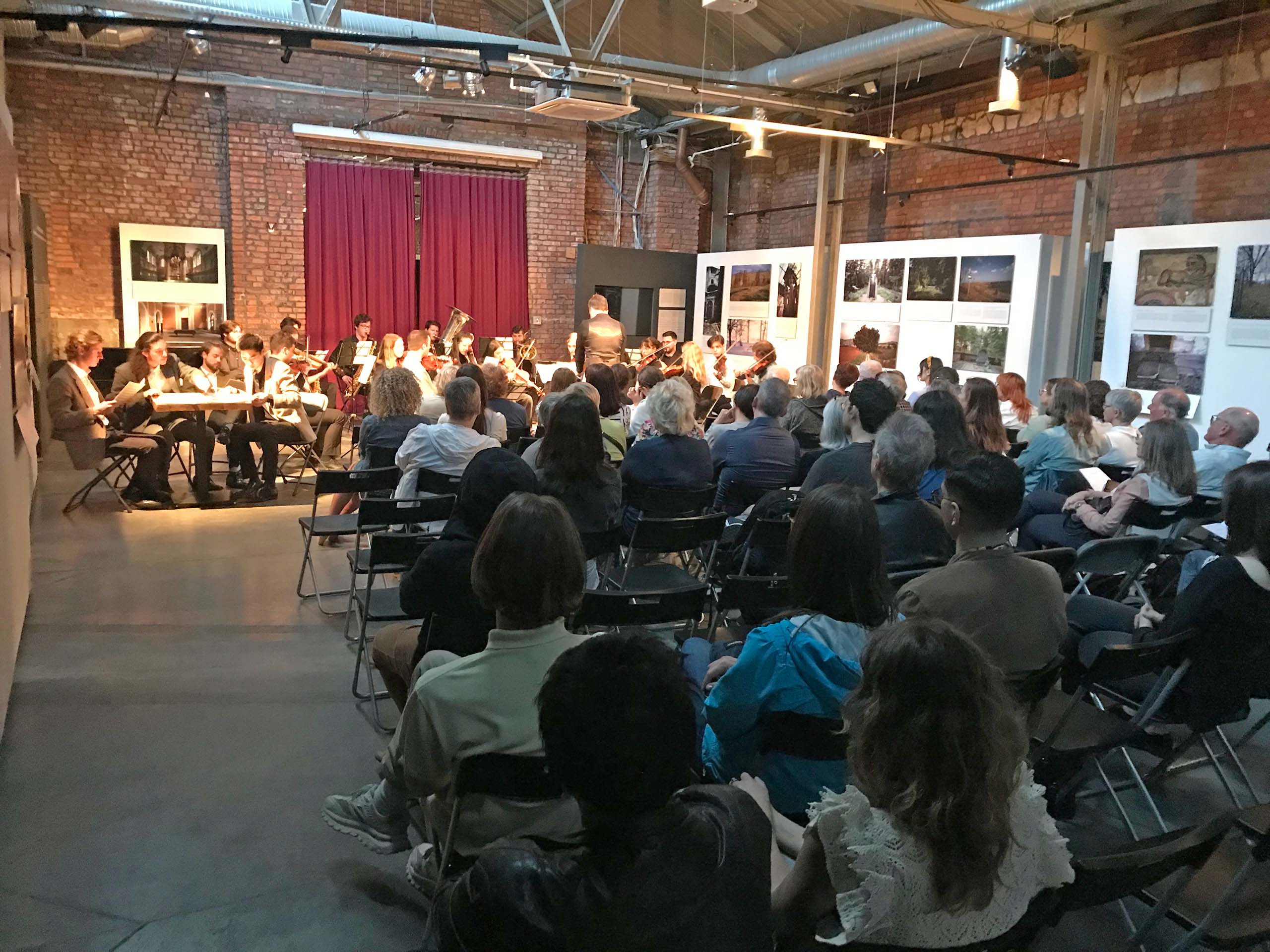The Music from Auschwitz Chamber Orchestra was formed to perform works that Professor Patricia Hall (music theory) uncovered in the archives of the Auschwitz-Birkenau State Museum. These musical manuscripts had been copied by hand and arranged by Polish political prisoners in the Auschwitz I men’s orchestra during World War II. The Music from Auschwitz Chamber Orchestra, consisting of SMTD students and conducted by Oriol Sans, former SMTD faculty member and current assistant professor and director of orchestral activities at the University of Wisconsin Mead Witter School of Music, has performed these works in several recitals. In May 2024, Hall, Sans, Professor Amanda Majeski (voice), and a group of SMTD students traveled to Austria and Poland to perform and to immerse themselves both in the musical culture of those countries and in the painful history of the Holocaust. Speaking of the impact of the trip, Hall said, “Traveling to the actual sites where the Auschwitz musicians performed, seeing the oak tree, the crematorium, and the remnants of the stage, transformed how the students performed and understood these foxtrots, waltzes, and tangos.”
As students in a pre-professional conservatory environment, we heavily focus on the “what” of our music. We spend countless hours toiling away at fundamental techniques, attending clinics and workshops with masters at our instruments, and presenting back-to-back concerts of standard repertoire for our given ensembles. Rarely do we get the opportunity to deeply examine our “why” – the reasons we spend so much time, energy, and effort to bring this music to audiences. So I was incredibly fortunate, as a member of the Music from Auschwitz Chamber Orchestra, to witness an important role that live music fulfills: providing a medium for performers and audiences alike to express and enjoy their humanity, even in the face of the darkest events in recorded history.
“Music from Auschwitz” was a project spearheaded by Professor Patricia Hall. Over many years of painstaking research, she sourced the actual manuscripts for ten musical works that were performed by prisoner musicians in the Auschwitz concentration camp from 1941–1945. These flexible arrangements were written for the atypical combination of voices, strings, saxophones, clarinets, trombone, and tuba that the imprisoned artists created. SMTD students formed a chamber orchestra to perform these works. In between each piece, one of the vocalists narrated a quote from an Auschwitz survivor recalling their experiences in the death camp. Cheerful German polkas, waltzes, and tangos stood in stark contrast to bone-chilling testimonies of inhumane living conditions, the unbridled brutality of the Gestapo, and the daily slaughter of tens of thousands of innocent people by the Nazis.

SMTD students and faculty on the Music from Auschwitz trip to Austria and Poland.
After a brief few days of rehearsals and informational lectures, we boarded our flight from Detroit to Frankfurt, Germany, where we hopped on a smaller plane bound for Vienna. Over the course of the next ten days in Vienna and Krakow, we would all become captivated by daily life in Europe: a gorgeous centuries-old palace or cathedral on every other block, excellent public transportation and walkability, and delicious food (my friends can attest to my newfound fondness for döner kebabs and radlers!).
We also had the privilege of indulging in Vienna’s rich culture of classical music, a refreshing experience for all of us who are working towards careers in the under-supported and volatile performing arts diaspora of the United States. It was commonplace to wander into a cathedral and catch an impromptu organ concert. Many of us visited the Vienna Central Cemetery and the graves of Schubert, Brahms, Strauss, and Schoenberg. In the evenings, we got standing-room tickets for chamber orchestras, symphony orchestras, and operas. Attending the Orchestra 1756’s performance of Vivaldi’s The Four Seasons at the St. Charles Cathedral was a personal highlight. Not only did this period-performance ensemble impress by taking bold and inspirational artistic liberties with Vivaldi’s venerable concerti, but the acoustics of St. Charles were surreal. I had no idea that eight string players could make such a huge space resonate so beautifully.
But even as we partook in fun events and tourist activities, we became increasingly aware of the painfully visible scars left on Europe by the Holocaust and its aftermath. At the Jewish Museum in Vienna, we learned about the pre-war villainization and post-war fragmentation of Jewish communities throughout the region. In Krakow, the Galicia Jewish Museum starkly depicted the Jewish community’s struggle to keep its legacy alive, as over the last 80 years the effects of both Mother Nature and humans have weathered away at the remnants of World War II–era ghettos and centuries-old synagogues and cemeteries in Poland. My knee-jerk reaction was of utter dismay: how could people walk past these reminders of genocide on their daily commutes, raise their families like normal in the immediate vicinity of monuments to human atrocity? But in the passing weeks since witnessing this duality, I have realized that perhaps it is best for humanity to receive daily reminders of history not to be repeated.
Touring the Auschwitz-Birkenau concentration camp was a disturbing experience. After growing up seeing pictures of Auschwitz in Poland’s austere winters, it was unnerving to witness the death camp in summer’s glory. The neat brick buildings of the smaller Auschwitz I camp were unassuming, and the expansive Birkenau complex had been mostly reduced to an open grassy field dotted by crumbling brick foundations. But the human carnage was all too evident. In Auschwitz I, the rooms of suitcases, shoes, and human hair formed a gut-wrenching display. At Birkenau, the dilapidated rubble piles of the Third Reich’s four enormous crematoriums testified to the pure evil committed inside. The only tangible trace of millions of murdered people was a series of memorial markers, indicating that the peaceful ponds and meadows next to the wreckage were full of human ash.
But amidst this evidence of death and destruction, we were able to understand why music matters. In these camps, music saved lives, not only by protecting the musicians from death labor, but by serving as an outlet for their humanity. At the archives in Auschwitz I, we had the privilege of viewing some of the original manuscripts and instruments used by the musicians in the camp. The camp’s trombonist had an incredible story: he was a non-musician who told the Nazis that he played trombone and got transferred from hard labor to the orchestra (ultimately saving his life). Seeing his tarnished and dented horn, knowing that it kept this man from facing the same fate of most of his fellow prisoners, was an extremely powerful experience. At the same complex, our tour guide took us to the now-overgrown pavilion where the prisoner orchestra would play weekly concerts for the Gestapo. Finally, during our tour of the Birkenau complex, we stopped by the foundation of the since-demolished barracks that had housed the women’s orchestra. Our tour guide brought out her computer, and we listened to a recording of that orchestra’s captivatingly beautiful arrangement of a Chopin piece. Knowing that such beauty could shine through the atrocities at the time…that moment will forever be a part of me.
Concluding our stints in Vienna and Krakow, we performed the “Music from Auschwitz” recital at the Jewish museum in each city. While our performance in Vienna was a quality musical presentation, nothing prepared us for how it would feel to perform that very same concert after touring Auschwitz. In our performance at Krakow’s Galicia Jewish Museum, the survivors’ testimonies and the contrastingly beautiful music interwove to depict a vivid story: one of suffering and needless violence, but also one of the resilience of the human spirit. Our audience in Krakow applauded for five minutes nonstop; I will never forget their appreciative smiles and cheering.
After one final free day in Krakow, we began the unceremonious voyage back to Detroit, complete with customs delays and excessively lengthy Frankfurt Airport terminals. But even as we got off the bus in Ann Arbor, jetlagged and ready to see our family and friends again, we knew that we had participated in a once-in-a-lifetime journey. To breathe new life into the very music that shone light during one of humanity’s darkest times was perhaps one of the most meaningful things that we could do with our music.




